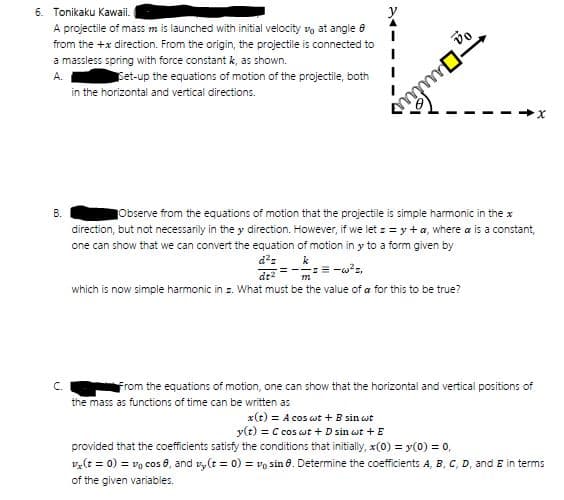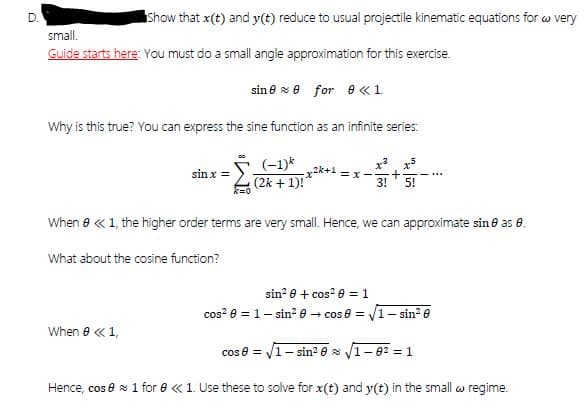Tonikaku Kawaii. A projectile of mass m is launched with initial velocity o at angle e from the +x direction. From the origin, the projectile is connected to a massless spring with force constant k, as shown. Eet-up the equations of motion of the projectile, both in the horizontal and vertical directions. A.
Tonikaku Kawaii. A projectile of mass m is launched with initial velocity o at angle e from the +x direction. From the origin, the projectile is connected to a massless spring with force constant k, as shown. Eet-up the equations of motion of the projectile, both in the horizontal and vertical directions. A.
University Physics Volume 1
18th Edition
ISBN:9781938168277
Author:William Moebs, Samuel J. Ling, Jeff Sanny
Publisher:William Moebs, Samuel J. Ling, Jeff Sanny
Chapter16: Waves
Section: Chapter Questions
Problem 43P: (a) Seismographs measure the arrival times of earthquakes with a precision of 0.100 s. To get the...
Related questions
Question
100%
Hi! I already have answers for parts A-C in this problem, but I'm having trouble with the last part (D.). Attached is the guide to answer it.
My answers for part C are:
A = 0
B = (V_o cos theta)/omega
C = -(mg)/k
D = (V_o sin theta)/omega
E = mg/k
I tried substituting these coefficients to the x(t) and y(t) formulas, but I still can't reduce them to the usual projectile
I hope you can help, thank you in advanced!

Transcribed Image Text:6. Tonikaku Kawaii.
A projectile of mass m is launched with initial velocity vo at angle e
from the +x direction. From the origin, the projectile is connected to
a massless spring with force constant k, as shown.
A.
Set-up the equations of motion of the projectile, both
in the horizontal and vertical directions.
В.
Observe from the equations of motion that the projectile is simple harmonic in the x
direction, but not necessarily in the y direction. However, if we let : = y + a, where a is a constant,
one can show that we can convert the equation of motion in y to a form given by
k
which is now simple harmonic in z. What must be the value of a for this to be true?
C.
From the equations of motion, one can show that the horizontal and vertical positions of
the mass as functions of time can be written as
x(t) = A cos wt +B sin wt
y(t) = C cos wt + D sin wt + E
provided that the coefficients satisfy the conditions that initially, x(0) = y(0) = 0,
v,(t = 0) = vg cos 8, and v, (t = 0) = vo sin 8. Determine the coefficients A, B, C, D, and E in terms
of the given variables.

Transcribed Image Text:D.
show that x(t) and y(t) reduce to usual projectile kinematic equations for w very
small.
Guide starts here: You must do a small angle approximation for this exercise.
sin 8 xe for 8 «1
Why is this true? You can express the sine function as an infinite series:
(-1)*
2k+1
(2k + 1)!
sin x =
=x-
3!
5!
When e «1, the higher order terms are very small. Hence, we can approximate sin e as 0.
What about the cosine function?
sin? e + cos? 8 = 1
cos? 8 = 1- sin? e - cos e = V1- sin? 6
When e « 1,
cos e = /1- sin? 0 1-02 = 1
Hence, cos e x 1 for 8 « 1. Use these to solve for x(t) and y(t) in the small w regime.
Expert Solution
This question has been solved!
Explore an expertly crafted, step-by-step solution for a thorough understanding of key concepts.
This is a popular solution!
Trending now
This is a popular solution!
Step by step
Solved in 4 steps

Knowledge Booster
Learn more about
Need a deep-dive on the concept behind this application? Look no further. Learn more about this topic, physics and related others by exploring similar questions and additional content below.Recommended textbooks for you

University Physics Volume 1
Physics
ISBN:
9781938168277
Author:
William Moebs, Samuel J. Ling, Jeff Sanny
Publisher:
OpenStax - Rice University

College Physics
Physics
ISBN:
9781938168000
Author:
Paul Peter Urone, Roger Hinrichs
Publisher:
OpenStax College

Classical Dynamics of Particles and Systems
Physics
ISBN:
9780534408961
Author:
Stephen T. Thornton, Jerry B. Marion
Publisher:
Cengage Learning

University Physics Volume 1
Physics
ISBN:
9781938168277
Author:
William Moebs, Samuel J. Ling, Jeff Sanny
Publisher:
OpenStax - Rice University

College Physics
Physics
ISBN:
9781938168000
Author:
Paul Peter Urone, Roger Hinrichs
Publisher:
OpenStax College

Classical Dynamics of Particles and Systems
Physics
ISBN:
9780534408961
Author:
Stephen T. Thornton, Jerry B. Marion
Publisher:
Cengage Learning

Principles of Physics: A Calculus-Based Text
Physics
ISBN:
9781133104261
Author:
Raymond A. Serway, John W. Jewett
Publisher:
Cengage Learning

Physics for Scientists and Engineers: Foundations…
Physics
ISBN:
9781133939146
Author:
Katz, Debora M.
Publisher:
Cengage Learning

College Physics
Physics
ISBN:
9781285737027
Author:
Raymond A. Serway, Chris Vuille
Publisher:
Cengage Learning